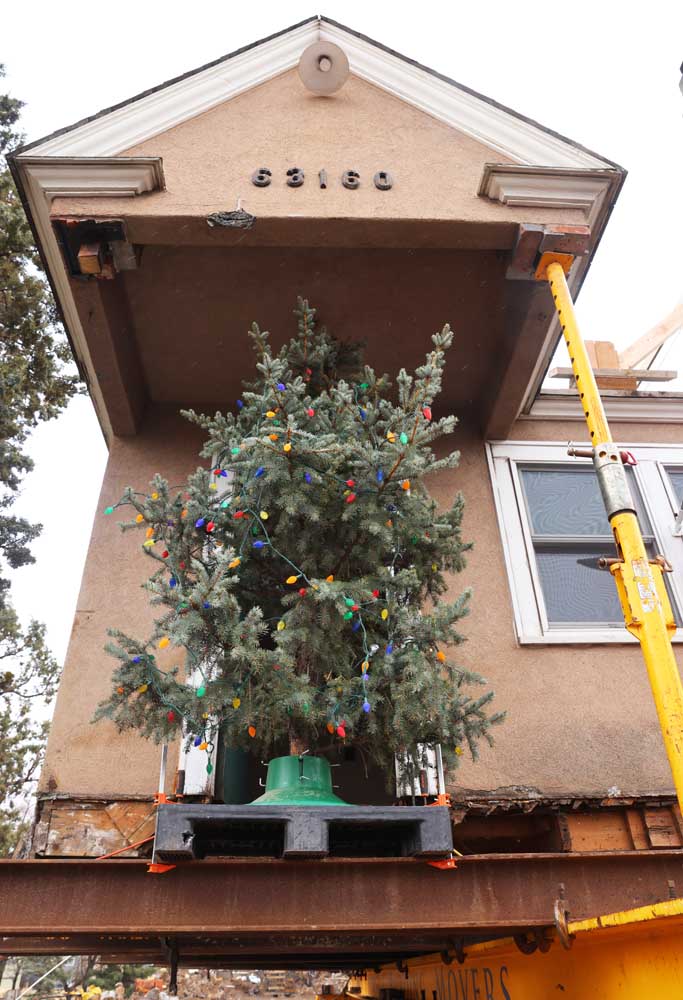Historic Nels and Lillian Anderson house moved 700 yards to make way for project
Published 5:00 am Wednesday, November 23, 2022

- A Christmas tree sits on the historic Nels and Lilian Anderson home Tuesday. The house was moved 700 yards to make way for the $175 million Bend North Corridor Project.
If you can’t move the highway project headed for your house, move the house instead.
That was the case Tuesday, when the historic Nels and Lillian Anderson house, built by Bend homesteaders in 1929, began a 700-yard move north to make way for a new Oregon Department of Transportation project.
The $175 million project, known as the Bend North Corridor Project, is expected to begin construction in January, and is scheduled to be fully completed by December 2024. The project will realign one of the most congested portions of U.S. Highway 97 in Bend, and improve a section of U.S. Highway 20. The new corridor is expected to improve traffic and make it easier for cyclists and pedestrians to access the area.
ODOT spokesperson Kacey Davey said the project will extend the Bend Parkway north.
“There will be an interchange up around Cooley where you’ll be able to continue on the parkway,” Davey said. “You’ll be able to come into town without hitting the traffic that has been stopping folks for a long time.”
There will also be two roundabouts installed, at Cooley Road and at Robal Lane on Highway 20, to keep traffic moving, Davey added. Part of the project required the historic Anderson house be moved to avoid its demolition.
The Anderson house, originally built at 63160 Nels Anderson Road, is a locally listed historical resource, said Heidi Kennedy, the senior planner on the Bend Landmarks Commission. Kennedy said the current owner of the house — Instant Landscaping owner Tim Larocco — bought it in 1999 and approached the landmarks commission in 2008 to get the house listed as a historical resource to ensure its protection.
Larocco said the house was initially chosen for its location, not its historic significance. It was rural and close to the parkway, he said.
“We grew to appreciate the historic value of it,” he said.
That appreciation, however, took a nudge from the city of Bend.
“But then the local historian for the city of Bend begged us to save the house, and we didn’t think it was feasible. It was in pretty bad shape back then,” Larocco said. “But learning the history behind it, we saved it, and our employees and our customers love it.”
Larocco said crews were in place to help guide the house on its short journey to 63291 Nels Anderson Road. Utility crews were in place to make sure the house did not hit any utility lines or equipment as it moved down the street.
The move, planned in conjunction with the city landmarks commission and ODOT, took a year to arrange, Larocco said.
“We had to dig into solid rock for a month to excavate a foundation crawl space, and the house movers (Wolfe House & Building Movers), they’ll go down the street, and they’ll actually turn the house and they’ll slowly put it into place down this gravel ramp right into this foundation plot that we built for it,” Larocco said. “And then they’ll crib it up… We only got a month and a half to build the foundation and to prepare the house to sit back down on the permanent foundation.”
Kelly Cannon-Miller, the executive director of the Deschutes County Historical Society, said the Anderson house, built in a distinct English Tudor style, was impressive for its time. She said Nels Anderson immigrated to the U.S. from Denmark in 1908, ending up in Bend in the early 1910s. In 1914, Anderson married Lillian, whose father had the homestead patent on the property dating to 1912. Lillian’s family came from Kansas, Cannon-Miller said, and the couple started their dairy farm on the property soon after their marriage.
“The historical society is excited that the new location is still within the boundaries of their (the Anderson’s) original farm,” Cannon-Miller said. “It is technically still within the footprint of Nels and Lillian’s dairy farm.”
Cannon-Miller said the goal of the homesteading act was to encourage agriculture in the region.
“All of that legislation from the federal government was designed to put land into agricultural production,” she said.
The Nels Anderson dairy farm is now hidden under the industrial development on the north end of town and the parkway, she said.
Cannon-Miller said the house is a unique historical site for the Bend community and that it speaks for a time that has largely disappeared. The house is the final echo from that past, and as Bend grows, and the freeway expands, the house will remain as a reminder of that past.






